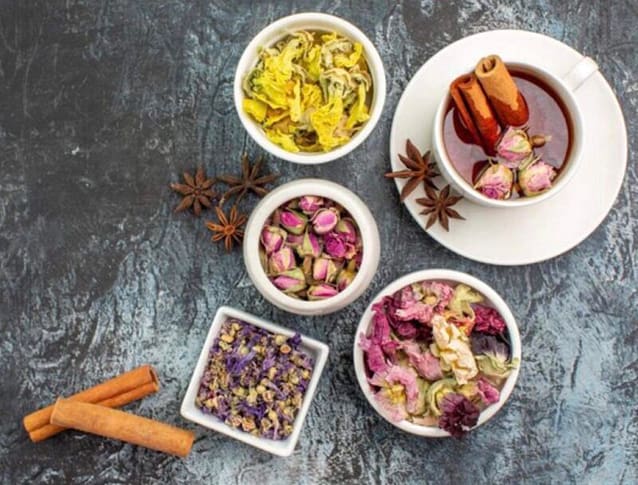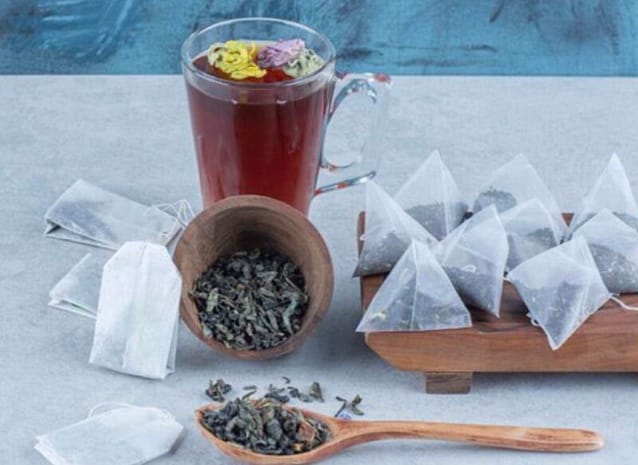To create DIY organic tea blends for health and flavor, select a quality tea base and combine it with herbs, spices, and dried fruits. Experiment with unique health benefits and delightful flavors.
I. Introduction
Welcome to the world of DIY Organic Tea Blends for Health and Flavor. In a time when wellness and personalization are paramount, crafting your tea blends is a delightful journey.
It's not just about tea; it's about creating tailored infusions that harmonize with your health and taste preferences. Let's explore the art and science of tea blending, unlocking the advantages of concocting teas that tantalize your palate and nourish your well-being.
II. The Basics of Tea Blending
A. Here are the fundamental principles of tea blending and the importance of selecting high-quality organic teas as the base
1. Balance of Flavors
Tea blending involves combining different teas, herbs and spices (know more about it in my blog post), or dried fruits to create a harmonious balance of flavors. It's essential to consider how each ingredient complements or contrasts.
2. Complementary Ingredients
Ingredients should work together to create a tea with a pleasing taste profile. For example, pairing a bold black tea with a touch of citrus zest can create a harmonious blend.
3. Health and Wellness Goals
Consider the health benefits you wish to incorporate. For instance, if aiming to create a calming blend, select herbs like chamomile or lavender that are known for their soothing properties.
4. Tea Base Selection
The base tea you choose sets the foundation for your blend. Selecting high-quality organic teas as the base is crucial. Organic teas are cultivated without synthetic pesticides or chemicals, preserving the integrity of the tea leaves and enhancing their natural flavor.
5. Freshness Matters
Ensure that the tea leaves used as the base are fresh. Stale or old tea can result in a lackluster blend. Organic teas are often sourced with freshness in mind, preserving their flavor and health benefits.
6. Organic Certification
Opt for teas with a recognized organic certification, it guarantees that the tea has been grown and processed under stringent organic standards. It ensures the absence of harmful chemicals and supports sustainable and environmentally friendly practices.
7. Experimentation
Don't be afraid to experiment with different base teas, such as green, black, white, or herbal varieties, to create a diverse range of blends.
The importance of starting with high-quality organic teas as the base cannot be overstated. These teas provide a solid foundation, ensuring that your blends are free from harmful chemicals and packed with the natural taste and health benefits that make tea blending a fulfilling and healthful endeavor.
III. Essential Tools and Ingredients
Here is the list of tools and equipment needed for tea blending and introducing various organic tea varieties to use as a base:
A. Tools and Equipment
1. Measuring Spoons
Accurate measurements are crucial for creating consistent blends.
2. Tea Infuser or Strainer
For steeping your blends.
3. Mortar and Pestle
Useful for crushing or grinding dried herbs and spices.
4. Air-Tight Containers
Essential for storing your blends to maintain freshness.
5. Labeling Materials
To mark the ingredients and brewing instructions on your tea blends.
6. Tea Scale
For precise measurements, especially when working with larger quantities.
B. Organic Tea Varieties as a Base
1. Green Tea
A gentle and fresh base, providing a slightly vegetal and grassy flavor. Green tea (check out my blog post about it) works well with herbs like mint and lemon verbena.
2. Black Tea
Offers a robust and bold base with a slightly astringent taste, perfect for blending with spices like cinnamon and cloves.
3. White Tea
Delicate and lightly sweet, white tea serves as an excellent base for floral and fruity blends. It pairs beautifully with dried fruits and flowers.
4. Herbal Teas
Herbal teas such as chamomile, lavender, or hibiscus (read my blog post about it) can serve as a base and flavoring, adding unique taste profiles and wellness advantages to your blends.
These organic tea bases serve as a canvas for your tea-blending creativity. Depending on your desired flavor and health benefits, you can choose the most suitable base and add complementary ingredients to craft your custom tea blends.

IV. Selecting Additional Ingredients
A. Let's explore a wide range of organic herbs, spices, dried fruits, and flowers to enhance your tea blends and offer guidance on ingredient selection based on desired flavors and health benefits:
1. Herbs
- Peppermint: Provides a refreshing and minty flavor, aids digestion, and offers a cooling effect.
- Chamomile: Imparts a gentle, floral taste, and is known for its calming and sleep-inducing properties.
2. Spices
- Cinnamon: Adds warmth and sweetness while potentially helping regulate blood sugar levels.
- Ginger: Offers a spicy and zesty kick, aids digestion, and has anti-inflammatory properties.
3. Dried Fruits
- Dried Citrus Peel: Enhances the aroma and imparts a bright, citrusy note.
- Dried Berries: Provides a sweet and fruity taste, rich in antioxidants.
4. Flowers
- Lavender: Bestows a floral and slightly sweet flavor, known for its calming and soothing effects.
- Hibiscus: Adds a tangy and vibrant taste while offering potential benefits for heart health.
5. Roots
- Licorice Root: Sweetens the blend and may aid in soothing sore throats and coughs.
- Dandelion Root: Imparts a mild, earthy flavor and may have detoxifying properties.
6. Nuts and Seeds
- Almonds or Almond Flakes: Add a nutty and slightly sweet taste to your blends.
- Cardamom Seeds: Bring a warm, spicy, and citrusy note to the mix.
7. Floral Petals
- Rose Petals: Contribute a delicate, floral aroma and sweet taste, often associated with relaxation.
B. When selecting ingredients for your tea blends, consider both flavor and health benefits
1. Desired Flavor
Choose ingredients that match the flavor profile you want to achieve. For example, if you're aiming for a soothing blend, select calming herbs like chamomile or lavender. If you desire a spicy and warming blend, opt for ginger and cinnamon.
2. Health Benefits
Some ingredients come with specific health advantages. For instance, peppermint and ginger can aid digestion, while hibiscus is packed with antioxidants that promote heart health.
By carefully selecting organic herbs, spices, dried fruits, and flowers, you can create tea blends that taste delicious. And offer unique wellness benefits that are tailored to your preferences and needs.
V. DIY Organic Tea Blends for Health and Flavor
Here are instructions for creating specific tea blend recipes, including flavor profiles and health advantages for relaxation and energy-boosting blends:
A. Relaxation Blend: Lavender Chamomile Delight
Ingredients:
- 2 parts dried chamomile flowers
- 1 part dried lavender buds
Instructions:
- Prepare Your Base: Start with a base of white or green tea leaves (1 teaspoon per 8 ounces of water). You can also choose caffeine-free herbal tea if you prefer.
- Mix the Herbs: Combine two parts dried chamomile flowers with one part dried lavender buds. For a single cup, use approximately 1 teaspoon of the chamomile-lavender mix.
- Steeping: Place your tea base and herbal mix in a tea infuser or strainer. Boil water and allow it to cool slightly (175-185°F or 80-85°C for white or green tea). Pour the hot water over the herbs and steep for 3-4 minutes.
- Enjoy: This blend creates a gentle, floral, and slightly sweet tea. Chamomile is renowned for its calming properties, while lavender adds soothing effects, making it an ideal choice for relaxation and stress relief.
B. Energy-Boosting Blend: Spicy Citrus Kick
Ingredients:
- 2 parts black tea leaves
- 1 part dried orange peel
- 1 part dried ginger root
- A pinch of cardamom seeds (adjust to taste)
Instructions:
- Select Your Base: Opt for black tea leaves as your base (1 teaspoon per 8 ounces of water).
- Blend the Ingredients: Combine two parts of black tea leaves with one part dried orange peel and one part dried ginger root. Add a pinch of cardamom seeds for extra spice. Adjust the quantities based on your desired flavor intensity.
- Brewing: Boil water (195-205°F or 90-96°C for black tea) and steep your tea blend for 3-5 minutes.
- Savor This blend results in a bold, spicy, and citrusy tea with a warming kick. Black tea provides an energy boost, while ginger and cardamom add zesty flavors. The dried orange peel enhances the citrus notes, making it an ideal choice for a morning or mid-afternoon pick-me-up.
These recipes offer a glimpse into the DIY tea blending, where you can tailor your tea to your preferences and wellness goals. Experiment with different ingredients and ratios to create unique, healthful tea blends.
VI. Storing and Packaging
Here’s how to properly store and package your homemade tea blends to maintain freshness and offer creative ideas for packaging:
A. Storing Your Tea Blends
1. Air-Tight Containers
The key to preserving freshness is storing tea blends in air-tight containers. Mason jars, glass containers, or specially designed tea tins work well.
2. Avoid Light and Moisture
Keep your containers away from direct sunlight and moisture. Store them in a cool, dry place.
3. Labeling
Clearly label your containers with the name of the blend, ingredients, steeping instructions, and the date of creation. This information is vital for anyone you may share the tea with.
4. Keep Original Containers
If you've used up an ingredient, such as dried fruit or herbs, retain the original packaging. It often has information, including expiration dates.
B. Packaging for Gifts or Personal Use
1. DIY Tea Bags
Create your tea bags by using empty tea bags or sachets. Fill them with your tea blend, and seal them with a stapler or by tying a string.
2. Glass Jars
Fill small glass jars with your blend and add a personalized label. Decorate the jar with ribbons or twine for an elegant touch.
3. Customized Labels
Craft custom labels or tags for each tea blend. You can include brewing instructions or a personal message for gift recipients.
4. Reusable Tins
Repurpose tea tins or decorative metal containers to store and gift blends. They're eco-friendly and add a vintage charm.
5. Organza Bags
Place your blend in organza bags and tie them with colorful ribbons. It not only looks appealing but also makes the tea easily accessible.
6. Personalized Tea Boxes
Design your tea boxes with compartments for different blends. Add artwork, illustrations, or quotes that resonate with the tea's theme.
7. Eco-Friendly Packaging
Choose eco-friendly options like biodegradable bags or recyclable materials. Include a note about the sustainable nature of your packaging.
8. Tea Gift Sets
Create a tea gift set with multiple blends. Arrange the blends in small jars or bags, and present them in a decorative box.
9. Gift Wrapping
For a special touch, wrap your tea blends in wrapping paper, cloth, or reusable fabric gift bags. It adds an element of surprise and thoughtfulness.
Remember that the packaging can be as creative and unique as your tea blends. Whether for personal use or gifting, the presentation adds to the charm of your homemade tea blends.

VII. Safety and Allergen Considerations
Addressing safety concerns and providing clear allergen information is crucial when creating and sharing homemade tea blends.
A. Here's how to do it:
1. Allergy Considerations
- Be aware of common allergies, such as nuts, dairy, or gluten, and avoid using ingredients that could trigger allergic reactions.
- If your blend includes allergenic ingredients, clearly state this on the label. For example, if your blend contains almond flakes, label it as "Contains Nuts."
2. Potential Herb Interactions
- Some herbs may interact with medications or medical conditions. If aware of any potential interactions, it's essential to communicate this on the label.
- For instance, if your blend contains an herb like St. John's Wort, which can interact with certain medications, label it with a warning such as "Consult a healthcare professional if taking medication."
3. Labeling Guidance
- Include a detailed ingredient list on your tea blend label. List all components, including the base tea, herbs, spices, dried fruits, and other ingredients.
- Indicate whether the blend is caffeinated or caffeine-free.
- Include steeping instructions for the best brewing experience.
- Mention the date of creation to ensure freshness and quality control.
- If your tea blend doesn't contain any allergenic ingredients, you can add a statement like "Allergen-Free" or "No Allergens."
4. Disclaimer for Educational Purposes
- Consider including a brief disclaimer on your label, emphasizing that your tea blends for educational and personal enjoyment. Mention that if someone has allergies or specific health concerns, they should consult a healthcare professional before consumption.
By addressing safety concerns and providing transparent allergen information, you ensure that tea blends are safe. This responsible approach enhances trust and allows everyone to enjoy your creations without worry.
VIII. Personalization and Experimentation
A. Encouragement:
- Embrace Creativity: Tea blending is an art, and your palate is the canvas. Don't be afraid to explore, mix, and match ingredients to discover what resonates with your taste and wellness objectives.
- Tailor to Your Needs: Whether it's a soothing bedtime tea, an energy booster, or an immune-boosting elixir, your tea blends can be customized to match your needs.
- Taste is Personal: What's perfect to one person may not be to another. Your perfect blend should delight your senses and satisfy your cravings.
B. Tips for Adjusting Recipes
1. Start with the Base
Begin with a base tea that suits your preferences. If you want a stronger flavor, opt for black tea; for a milder taste, choose white or green tea.
2. Consider Ratios
Adjust ingredient ratios to fine-tune the flavor. Add more of a dominant ingredient for a bolder taste or reduce it for subtlety.
3. Test and Taste
As you blend, taste the tea at various stages. It helps you monitor the flavor development and adjust on the go.
4. Balancing Act
Balance is key. For an overpowering spice, you might need a sweet or mellow ingredient to harmonize the flavors.
5. Keep Notes
Maintain a blending journal to document your experiments. Note what works and what doesn't to guide future creations.
6. Small Batches
When experimenting, create small batches. It's easier to adjust and refine the blend in smaller quantities.
7. Be Patient
The flavors may evolve. Allow the blend to sit for a day or two to meld and develop complexity.
8. Seek Inspiration
Draw inspiration from traditional tea blends and cuisines. Traditional recipes can offer insights into ingredient combinations.
9. Don't Fear Mistakes
Not every experiment will yield a favorite blend. Mistakes are part of the learning process.
By encouraging readers to embrace experimentation and offering these tips, you empower them to create tea blends that resonate with their unique tastes and wellness goals. The journey of tea blending is as much about the process as it is about the result, and a delightful journey to embark on.
IX. Additional References
- Compositions and Antioxidant Activity of Tea Polysaccharides Extracted from Different Tea (Camellia sinensis L.) Varieties (2023) https://www.ncbi.nlm.nih.gov/pmc/articles/PMC10572641/
- Antimicrobial activities of widely consumed herbal teas, alone or in combination with antibiotics: an in vitro study (2017) https://www.ncbi.nlm.nih.gov/pmc/articles/PMC5533155/
- Extraction Kinetics of phytochemicals and antioxidant activity during black tea (Camellia sinensis L.) brewing (2015) https://www.ncbi.nlm.nih.gov/pmc/articles/PMC4520228/
X. Conclusion
We've embarked on a delightful journey through the world of DIY Organic Tea Blends for Health and Flavor. This artful pursuit combines the senses, creativity, and wellness in a single cup, making it more than just a beverage—it's a fulfilling and healthful hobby.
The canvas for your tea-blending adventures is boundless, and your imagination is the limit. Experiment with herbs, spices, fruits, and flowers to create blends that cater to your unique tastes and wellness aspirations.
From soothing bedtime infusions to revitalizing morning pick-me-ups, your tea blends can be tailored to your needs and desires. As we've explored, every sip is a revelation, a masterpiece of taste and wellness.
And the best part? The journey never ends. It's a continuous exploration, a never-ending source of inspiration, and a journey that invites you to experiment, learn, and share.
So, with your tea leaves, herbs, and spices at hand, embrace the art of DIY Organic Tea Blends. Craft unique flavors that delight your senses, nourish your well-being, and allow you to share your passion with friends, family, and our growing community of tea enthusiasts.
Remember, the path to your perfect blend may be full of twists and turns, but each twist is a new opportunity for discovery. As you sip from your cup of creative, homemade tea, you're not just enjoying a beverage; you're savoring the fulfillment of crafting a healthful masterpiece, one sip at a time.
Cheers to your journey, your creativity, and your well-being!
XI. My Experience
My experience practicing adventurous experimentation in the taste profiles of different tea combinations has been an absolute joy. Crafting my unique tea blends through DIY Organic Tea Blends for Health and Flavor is an exhilarating experience.
Each blend becomes a canvas for creativity, an opportunity to mix and match, and a chance to discover new and exciting flavors. It's not just about tea; it's about the satisfaction of knowing that with every sip.
Savoring a one-of-a-kind creation tailored to my exact preferences. The world of tea is vast and diverse, and a journey I wholeheartedly embrace, relishing the creative process and the healthful rewards it offers.
Your tea-blending journey is unique, and I'd love to hear about your experiences and discoveries.
Share your stories, recipes, and flavor adventures with our community. And while here, don't forget to explore our other blog posts for even more insights into the world of DIY Organic Tea Blends for Health and Flavor.
Let's sip, learn, and grow together!

 Simple. Natural. Better.
Simple. Natural. Better.